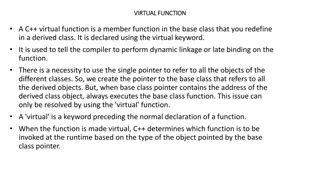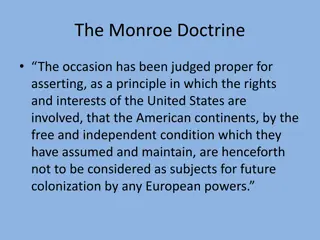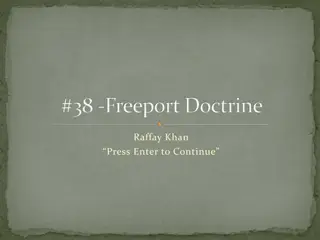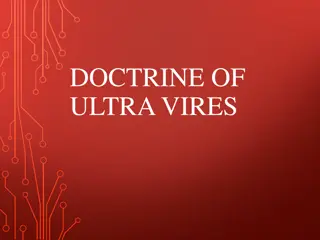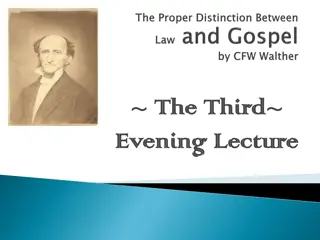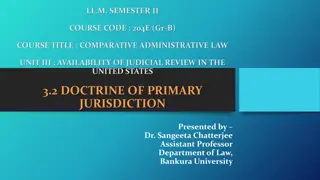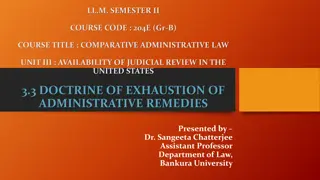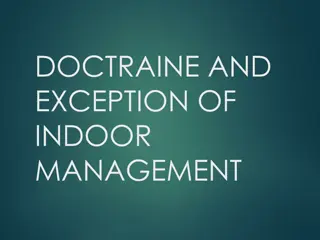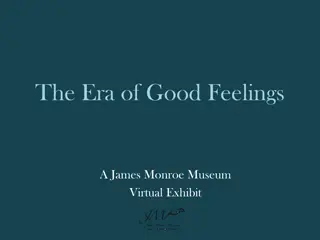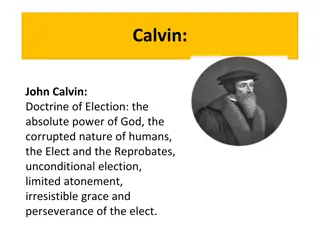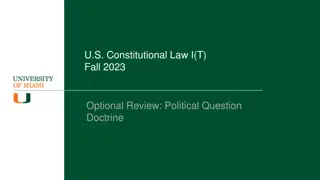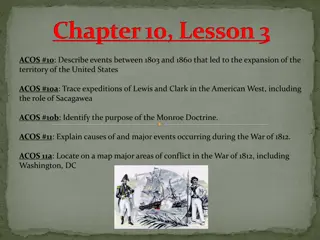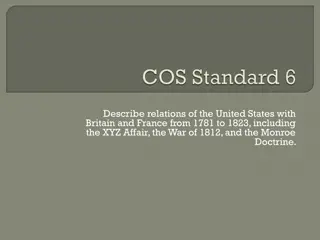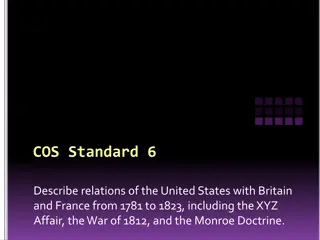America Enters the World Stage: The Monroe Doctrine Virtual Exhibit
James Monroe's significant impact on American foreign policy, particularly through the Monroe Doctrine, is showcased in a virtual exhibit exploring his presidency and diplomatic legacy. From the Monroes' ambassadorial attire in Paris to the historical context of the doctrine's proclamation, delve into a pivotal period in American history that shaped its role on the global stage.
Download Presentation

Please find below an Image/Link to download the presentation.
The content on the website is provided AS IS for your information and personal use only. It may not be sold, licensed, or shared on other websites without obtaining consent from the author. Download presentation by click this link. If you encounter any issues during the download, it is possible that the publisher has removed the file from their server.
E N D
Presentation Transcript
America Enters The World Stage: |The Monroe Doctrine| A James Monroe Museum Virtual Exhibit
|Introduction| When James Monroe became President in 1817, he had already served as an ambassador to France, negotiated the Louisiana Purchase, and served as Secretary of State during the War of 1812. America was expanding, both in size and in influence, and a new American identity was being formed after the war. Monroe made significant contributions to American foreign policy throughout this life, most notably through the Monroe Doctrine.
|The Exhibits| IMG_0381.jpg JM91.005AA.1.jpg monroe doctrine.jpg The Monroes in Paris The Doctrine s Legacy The Monroe Doctrine Click an Object to Enter
|The Monroes in Paris| {1794-1796} The Monroes represented all of America when they were ambassadors in Europe, at a time when an American identity was still forming. What did they seek to convey through their appearances?
|The Monroes in Paris| James Monroe wore this three-piece court suit decorated with nine ornate steel buttons, faceted to give the illusion of brilliant stones. JM76.219 Elizabeth Monroe wore this fawn-colored silk velvet dress to the coronation. Its empire style was popular during the French court of Napoleon I. JM.76.240
|The Monroes in Paris| What do you think the Monroes were trying to communicate with their clothes? How would you describe their appearance?
|The Monroes in Paris| The way the Monroes dressed in Paris was intentional and designed to assist them in presenting a favorable view of America to aid in ambassadorial responsibilities.
|The Exhibits| IMG_0381.jpg JM91.005AA.1.jpg monroe doctrine.jpg The Monroes in Paris The Doctrine s Legacy The Monroe Doctrine Click an Object to Enter
|The Monroe Doctrine| In his seventh annual address to Congress on December 2, 1823, President Monroe first articulated the Monroe Doctrine, declaring that European powers must respect the Western Hemisphere as the United States sphere of influence. What was the context of the Monroe Doctrine and how did it impact the United States relations with the world?
|The Monroe Doctrine| as a principle in which the rights and interests of the United States are involved, the American continents, by the free and independent condition which they have assumed and maintain, are henceforth not to be considered as subjects for future colonization by any European powers...
|Reading Primary Sources| What was Monroe declaring to the world?
|The Monroe Doctrine| Did the Monroe Doctrine change the way America was viewed by other countries? If so, how? Did Europeans take the Monroe Doctrine and America as a nation seriously? Was it possible for America to be isolated during the early Republic?
|The Monroe Doctrine| The Monroe Doctrine became a foundation piece of American foreign policy and helped solidify a new American identity to the world. In declaring the Western Hemisphere unavailable to European interference, it also warned that the United States would interpret any foreign involvement there as aggression. The immediate purpose of the doctrine was to defend the U.S. s interests in its closest neighbors. But because of this, other nations in the Western Hemisphere and elsewhere have not always regarded the doctrine favorably.
|The Exhibits| IMG_0381.jpg JM91.005AA.1.jpg monroe doctrine.jpg The Monroes in Paris The Doctrine s Legacy The Monroe Doctrine Click an Object to Enter
|The Legacy of the Monroe Doctrine| Since Monroe s presidency, the Monroe Doctrine has become central to America s foreign policy. However, it hasn t always been interpreted the same way. How has the Monroe Doctrine been applied and interpreted throughout American history?
|The Legacy of the Monroe Doctrine| Applications of the Monroe Doctrine: Applications of the Monroe Doctrine: 1864: Napoleon III s invasion of Mexico 1870: US declares authority to mediate South American border disputes 1904: The Roosevelt Corollary 1962: Communism in Cuba- Kennedy and the Cuban Missile Crisis 1980s: US involvement in civil wars in El Salvador and Nicaragua 2003: Bush Corollary : Iraq invasion
|Reading Primary Sources| How did Johnson view the Monroe Doctrine? How do you think Johnson and President Kennedy applied the Monroe Doctrine to their times?
|Questions for Discussion| How have future Presidents used and interpreted the Monroe Doctrine? Which applications of the Monroe Doctrine do you agree with? With which do you disagree? Do you think invoking the Monroe Doctrine with reference to Communism in the 1960s is an appropriate interpretation of Monroe s statements?
|The Legacy of the Monroe Doctrine| From its beginnings, the interpretation of the Monroe Doctrine has been complex and at times controversial. Nevertheless, the document has been and remains central to American foreign policy and has been invoked at significant points in U.S. history, from the South American border disputes to modern conflicts in the Middle East.


